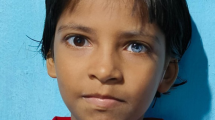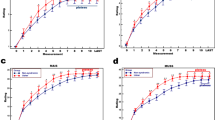Abstract
Waardenburg syndrome (WS) is an autosomal dominant disease, characterized by dystopia canthorum, hyperplasia of the eyebrows, heterochromia iridis, white forelock, and congenital sensori-neural hearing loss (SNHL). The aim of this study was to evaluate the outcome of cochlear implantation in children with WS and compare it with children with pure SNHL. In a prospective study we evaluated 336 cochlear implanted children from 2008 to 2010. The WS was diagnosed by its established criteria and for control group children without any dysmorphic features, anatomical, behavioral, and developmental disorders were also enrolled. We evaluated children of both groups 1 year after cochlear implantation by categories of auditory performance (CAP) and speech intelligibility rating (SIR) tests. Eighty-one children out of the total 336 who had SNHL were included in study. Out of these 75 (22.3%) were healthy and six (1.78%) had WS. Of the 75 healthy children 40 (53.3%) were girls, while of the six children with WS, three (50%) were girls. There was a significant difference in SIR between WS and cases with pure SNHL (2.67 ± 1.03 vs. 3.79 ± 1.11, p = 021) however, the difference was not significant in CAP (4 ± 1.26 vs. 5.13 ± 1.13, p = 0.082). Prevalence of WS was 1.78% at Baqiyatallah Cochlear Implant Center. One year after implantation there was no significant difference in auditory outcome; however, the difference in speech outcome was significant between WS and cases with pure SNHL.
Similar content being viewed by others
References
Wang NM et al (2007) Pediatric cochlear implantation in Taiwan: long-term communication outcomes. Int J Pediatr Otorhinolaryngol 71(11):1775–1782
Waltzman SB et al (2002) Long-term effects of cochlear implants in children. Otolaryngol Head Neck Surg 126(5):505–511
Archbold SM et al (2000) Approach to communication, speech perception and intelligibility after paediatric cochlear implantation. Br J Audiol 34(4):257–264
Geers AE (2004) Speech, language, and reading skills after early cochlear implantation. Arch Otolaryngol Head Neck Surg 130(5):634–638
McConkey Robbins A, Green JE, Waltzman SB (2004) Bilingual oral language proficiency in children with cochlear implants. Arch Otolaryngol Head Neck Surg 130(5):644–647
O’Donoghue GM, Nikolopoulos TP, Archbold SM (2000) Determinants of speech perception in children after cochlear implantation. Lancet 356(9228):466–468
Nicholas JG, Geers AE (2006) Effects of early auditory experience on the spoken language of deaf children at 3 years of age. Ear Hear 27(3):286–298
Geers A, Brenner C, Davidson L (2003) Factors associated with development of speech perception skills in children implanted by age five. Ear Hear 24(1 Suppl):24S–35S
Bauer PW et al (2002) Cochlear implantation in children with CHARGE association. Arch Otolaryngol Head Neck Surg 128(9):1013–1017
Read AP, Newton VE (1997) Waardenburg syndrome. J Med Genet 34(8):656–665
Konno P, Silm H (2001) Waardenburg syndrome. J Eur Acad Dermatol Venereol 15(4):330–333
Calmels MN et al (2004) Speech perception and speech intelligibility in children after cochlear implantation. Int J Pediatr Otorhinolaryngol 68(3):347–351
Vivero RJ et al (2010) Cochlear implantation in common forms of genetic deafness. Int J Pediatr Otorhinolaryngol 74(10):1107–1112
Nikolopoulos TP et al (2008) Speech production in deaf implanted children with additional disabilities and comparison with age-equivalent implanted children without such disorders. Int J Pediatr Otorhinolaryngol 72(12):1823–1828
Pau H et al (2006) Cochlear implantations in children with Waardenburg syndrome: an electrophysiological and psychophysical review. Cochlear Implants Int 7(4):202–206
Cullen RD et al (2006) Cochlear implants in Waardenburg syndrome. Laryngoscope 116(7):1273–1275
Kaufmann L, Sauter TB, Lee DJ (2010) Dysplasia of the cerebellum in Waardenburg syndrome: outcomes following cochlear implantation. Int J Pediatr Otorhinolaryngol 74(1):93–96
Loundon N et al (2005) Cochlear implantation in children with internal ear malformations. Otol Neurotol 26(4):668–673
Rajput K, Brown T, Bamiou DE (2003) Aetiology of hearing loss and other related factors versus language outcome after cochlear implantation in children. Int J Pediatr Otorhinolaryngol 67(5):497–504
Yang HM et al (2004) The auditory performance in children using cochlear implants: effects of mental function. Int J Pediatr Otorhinolaryngol 68(9):1185–1188
Kontorinis G et al (2011) Outcomes and special considerations of cochlear implantation in waardenburg syndrome. Otol Neurotol 32(6):951–955
Sugii A et al (2000) Cochlear implant in a young child with Waardenburg syndrome. Adv Otorhinolaryngol 57:215–219
Moon SK et al (2004) Cochlear implantation in a case with Waardenburg syndrome. Cochlear Implants Int 5(Suppl 1):212–214
Migirov L et al (2005) Cochlear implantation in Waardenburg’s syndrome. Acta Otolaryngol 125(7):713–717
Daneshi A, Hassanzadeh S, Farhadi M (2005) Cochlear implantation in children with Waardenburg syndrome. J Laryngol Otol 119(9):719–723
Suarez H et al (2007) Balance sensory organization in children with profound hearing loss and cochlear implants. Int J Pediatr Otorhinolaryngol 71(4):629–637
Baldassari CM et al (2009) Receptive language outcomes in children after cochlear implantation. Otolaryngol Head Neck Surg 140(1):114–119
Wan L et al (2010) Cochlear implantation in patients with Waardenburg syndrome type II. Lin Chung Er Bi Yan Hou Tou Jing Wai Ke Za Zhi 24(10):436–438
Deka RC et al (2010) Cochlear implantation in Waardenburg syndrome: the Indian scenario. Acta Otolaryngol 130(10):1097–1100
Acknowledgments
The authors thank parents of children who kindly participated in this investigation. The authors would also like to express their gratitude to Dr. Mohsen Reza Haidari for reviewing and meticulous extensive editing of the English text.
Conflict of interest
None of authors have conflict of interest.
Author information
Authors and Affiliations
Corresponding author
Rights and permissions
About this article
Cite this article
Amirsalari, S., Ajallouyean, M., Saburi, A. et al. Cochlear implantation outcomes in children with Waardenburg syndrome. Eur Arch Otorhinolaryngol 269, 2179–2183 (2012). https://doi.org/10.1007/s00405-011-1877-3
Received:
Accepted:
Published:
Issue Date:
DOI: https://doi.org/10.1007/s00405-011-1877-3




